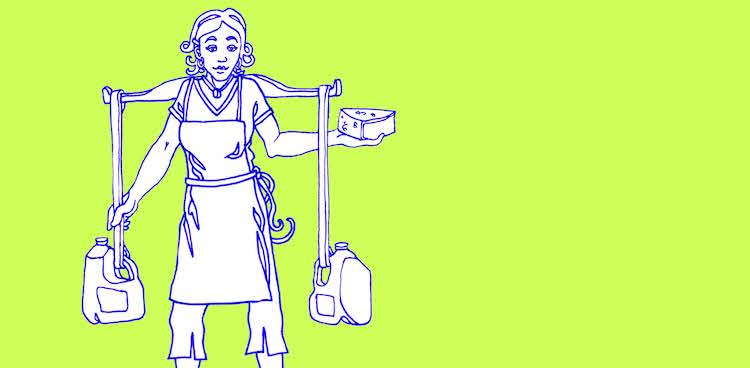
You always remember the day you asked, “Mommy, where does cheese come from?”
Boy, how embarrassing was that? For those not yet acquainted with the birds and the bees, let me clear up one thing: There is no cheese without women. Or female mammals, at least.
Dairy has been a female domain from the beginning. After all, there is no male version of the word milkmaid. (Of course, men gather milk too, but milklad just doesn’t sound right.) Along with many other farm chores, milking was often a daughter’s responsibility, and the job came to be associated with young women.
While you might think of blond Tyroleans skipping through mountain pastures, milkmaids are actually a diverse bunch, tracing back from the Indian god Krishna’s sexy gopis, to Edward Jenner’s cowpox-inoculated farm girls, to Marie Antoinette, playing at the job with her silver pail and ivory milking stool. Besides chapped hands, what they’ve got in common is the way they embody a kind of unspoiled—or, in Marie Antoinette’s case, supremely spoiled—girlish femininity. And just like people think of beefy butchers or plump bakers, milkmaids seem to reflect the creamy purity of their product.
But if we’re talking milk, we’re not just talking about maidens. We’re talking about mothers. And before you ask, no. Despite some silly Internet hoaxes, breast-milk cheese does not exist; human milk lacks the right proteins to form curds. But the connection between cheese and motherhood is strong enough to have spawned a women-only custom in the British Isles. Kenno (pronounced dunno) is also called caajey in Manx and kebbock among the Scottish. It’s a secret cheese eaten by a group of women who pray for a mother in labor. Sir Walter Scott wrote about the custom in 1815:
“A large and rich cheese was made by the women of the family, with great affectation of secrecy, for the refreshment of the gossips who were to attend at the ‘canny minute’ of birth. This was the ken-no, so called because its existence was secret (that is, presumed to be so) from all the males of the family, but especially from the husband and master. He was accordingly expected to conduct himself as if he knew of no such preparation, to act as if desirous to press the female guests to refreshments, and to seem surprised at their obstinate refusal. But the instant his back was turned the ken-no was produced… The remainder was divided among the gossips, each carrying a large portion home with the same affectation of great secrecy.”
Of course, being a culture reader, you’re probably wondering what kind of cheese the kenno is, right? Alas, beyond “very rich,” Sir Scott doesn’t give much clue. Another report, from the Isle of Man, says the cheese was made from “milk with the whey squeezed out, and had plenty of salt in it.” Still pretty vague.
This may call for an experiment. Find an expectant female relative, circle up your distaff friends, and smuggle a wheel of something into the hospital. Repeat until you find the perfect secret women’s-labor-blessing cheese.



